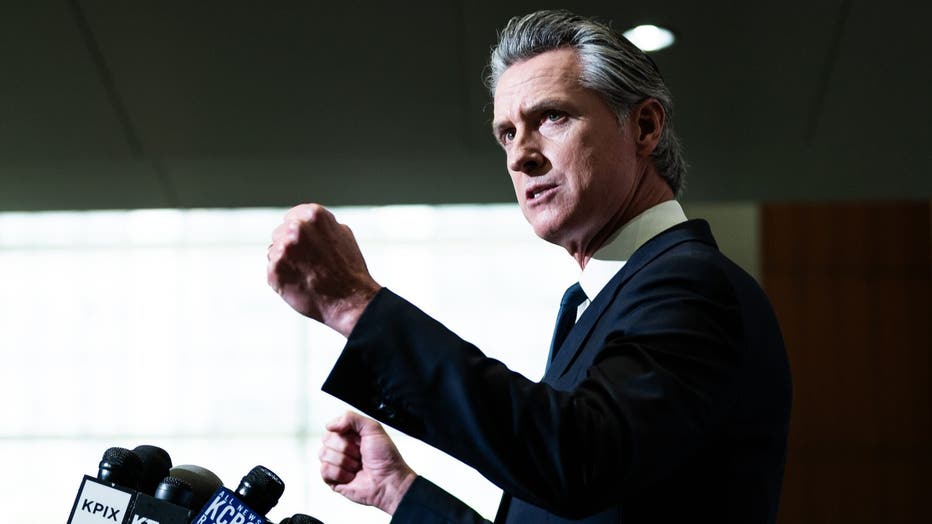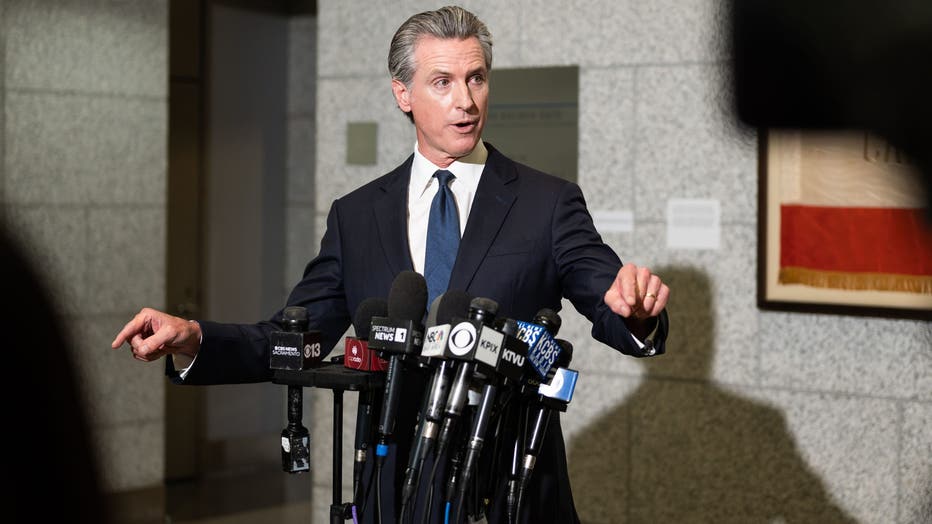Appeals court temporarily blocks judge's ruling to return control of National Guard to California

Judge rules in favor of Newsom in legal battle over National Guard
Judge says Trump illegally called up National Guard to assist with LA protests and must return control to governor.
SAN FRANCISCO - A federal judge on Thursday ruled in favor of California Gov. Gavin Newsom, granting a temporary restraining order that directs President Donald Trump to return control of the National Guard to the governor. However, within hours, the 9th U.S. Circuit Court of Appeals temporarily blocked that federal judge's order.
The White House called the order "unprecedented" and said it "puts our brave federal officials in danger."
The block came shortly after the judge ruled the Guard deployment was illegal and both violated the Tenth Amendment and exceeded Trump's statutory authority.
The court said it would hold a hearing on the matter on June 17.

California Gov. Gavin Newsom at a news conference following a federal judge's ruling against the Trump administration to place the National Guard under the governor's control. June 12, 2025. (Photo credit: Jaden Schaul)
Trump does not have authority, judge rules
"We’re talking about the president exercising his authority, and the president is, of course, limited in that authority. That’s the difference between a constitutional government and King George," U.S. District Judge Charles Breyer said in court.
The legal showdown between Newsom and Trump played out in a federal courtroom in San Francisco, centering on whether the president had the authority to deploy the California National Guard and U.S. Marines to quell anti-ICE protests in Los Angeles without the governor’s consent.
Breyer ruled that Trump did not have that authority, declaring the deployment illegal and a violation of both the 10th Amendment and federal law.
"This country was founded in response to a monarch, and the Constitution is a document of limitations. I'm trying to figure out where the lines are drawn," Breyer said in court.
He ordered the California National Guard back under Newsom’s control by noon on Friday. That order was temporarily blocked by an appeals court.
National Guard would have returned to day jobs
"The National Guard, men and women, will go back to their day jobs," Newsom said following the ruling. "It will come back under the rightful command of the governor."
In a social media post, Newsom said that the court confirmed "what we all know — the military belongs on the battlefield, not on our city streets. This win is not just for California, but the nation. It’s a check on a man whose authoritarian tendencies are increasing by the day.End the illegal militarization of Los Angeles now, @realDonaldTrump. History is watching."
The White House had no immediate comment on the ruling, but the federal government immediately filed an appeal with the Ninth Circuit court, which granted a stay.
Newsom's argument
Newsom filed a lawsuit earlier this week, arguing that Trump did not have constitutional authority to federalize the National Guard without the governor’s consent or coordination.
Trump countered that he indeed had the power to call in the military to protect federal buildings, property, and personnel.
"Courts did not interfere when President Eisenhower deployed the military to protect school desegregation. Courts did not interfere when President Nixon deployed the military to deliver the mail in the midst of a postal strike. And courts should not interfere here either," the White House legal team wrote in a brief.

California Gov. Gavin Newsom at a news conference following a federal judge's ruling against the Trump administration to place the National Guard under the governor's control. June 12, 2025. (Photo credit: Jaden Schaul)
Title 10 allows the president to call the National Guard into federal service under certain limited circumstances, such as when the country "is invaded," when "there is a rebellion or danger of a rebellion against the authority of the Government," or when the president is unable "to execute the laws of the United States."
The lawsuit argued that Title 10 also requires that the president go through governors when issuing orders to the National Guard.
Breyer said in his ruling that what is happening in Los Angeles does not meet the definition of a rebellion.
"The protests in Los Angeles fall far short of ‘rebellion,’" he wrote.
Ahead of the judge's order, Newsom argued in the 22-page lawsuit against Trump and Secretary of Defense Pete Hegseth that the president invoked emergency powers that "exceed the bounds of lawful executive authority," and that Americans should be governed by civil, not military rule.

California Gov. Gavin Newsom at a news conference following a federal judge's ruling against the Trump administration to place the National Guard under the governor's control. June 12, 2025. (Photo credit: Jaden Schaul)
Newsom and California Attorney General Rob Bonta wrote to the court, challenging Trump’s use of Title 10 to send in 4,000 California National Guard troops to Los Angeles after protests broke out there, some of which were destructive, to quell the crowds.
And in fact, Newsom's team argued, it was the federal ICE agents who inflamed tensions, not the protesters.
While there have been some pockets of protester unrest, Newsom's team wrote: "At no point in the past three days has there been a rebellion or insurrection."
Nor have the protests risen to the level of protests or riots that Los Angeles and other major cities have seen at points in the past, they argued.
The last time the National Guard was federalized for riot control was in 1992 – at the governor's request – during the Rodney King riots.
Newsom and Bonta contended that the Constitution reserves the power to deploy the Guard to the states unless they request federal assistance.
"Only under the most exigent of circumstances can the president, over the objections of a state," call the National Guard into federal service, Newsom's team said. This is the only way to check "federal overreach," they argued.

Is California's move to block the National Guard a political stunt?
Is California's move to block the National Guard a political stunt? That's what President Trump called Gov. Gavin Newsom's move to block the federalization of the National Guard.
Trump's argument
Trump was represented in court by Assistant Attorney General Brett Shumate and Department of Justice attorneys Eric Hamilton, Alexander Haas, Christopher Edelman, Garry Hartlieb, and Benjamin Kurland.
They argued Newsom engaged in a "crass political stunt endangering American lives," as he sought to block the president from "exercising his lawful statutory and constitutional power to ensure that federal personnel and facilities are protected."
Trump's team said in a 59-page court filing Wednesday that the reason the president had the authority to bring in the National Guard was because there have been "violent rioters" in Los Angeles, who have vandalized buildings and property, and injured law enforcement officers, which the Los Angeles Police Department has not been able to quell.
Trump's legal team cited what LAPD Chief Jim McDonnell said at a news conference, where he told the public that "things have gotten out of control" and warned that "somebody could easily be killed."
Because of that, either that the local police were "unable or unwilling to control" the crowd, Trump responded by using the "authority vested in him by statute and the Constitution to federalize and deploy the California National Guard to protect federal personnel and property, quell the mobs, and restore order," Trump's lawyers wrote to the judge.
Trump properly invoked his statutory authority to federalize the California National Guard, a sensitive judgment that the president holds by law and to "which the courts owe the highest deference," his lawyers said.
And in terms of the Marines and the National Guard, Trump's team said they had not engaged in law enforcement, rather than protect law enforcement.

Mayor of LA, California leaders call for end to ICE sweeps amid protests, military involvement
Mayor Karen Bass and other regional leaders are calling for ICE to end its sweeps and blasting the deployment of National Guard members and Marines in Los Angeles. Her call comes amid ongoing enforcement and protests.
Legal experts
Before the order was made, UC College of the Law Professor David Levine told KTVU that the judge had a "very tricky" situation to decide.
And in the end, Levine guessed that the judge wouldn't make either side completely happy.
"I think he's going to ask very skeptical questions of both sides," Levine said. "I think he's going to try and strike a middle path."

The California National Guard stands by ICE agents in Los Angeles. June 10, 2025. Photo: ICE

